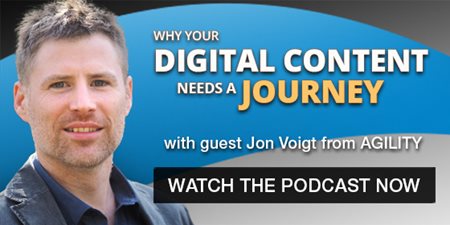Podcast: The Content Journey and an Interview with Agility
By Laura Myers
December 24, 2018
Agility, B2B Content Marketing, content, Content Journey as a Service, content marketing, Content Strategy, Digital Marketing, Jon Voigt, marketing, Podcast, Video Content, Visual Content
While it’s a nice idea to think that you can convert a customer with one piece of content, those instances  are few and far between. Back in 2015, Salesforce shared that it takes anywhere from 6 to 8 touchpoints to generate a viable sales lead. Given that the dynamics of the attention economy have become even more strenuous in the last 3 years, I assume that number is inching even higher.
are few and far between. Back in 2015, Salesforce shared that it takes anywhere from 6 to 8 touchpoints to generate a viable sales lead. Given that the dynamics of the attention economy have become even more strenuous in the last 3 years, I assume that number is inching even higher.
This is why creating a journey is key to your content strategy. If only to support the sales team in running a content strategy parallel to the sales funnel to show solidarity in reaching the joint goal of growth and increased revenue. Content also might be the best way to move the needle considering that in 2017 Hubspot shared a stat from the Content Marketing Institute noting that content marketing gets three times more leads than paid search advertising. It’s also increasingly important in the B2B space to have a solid content strategy in place that pulls in significant thought leadership from your company. Hubspot shared in the same 2018 report that 96% of B2B buyers want content with more input from thought leaders. 2019 is the year to deliver on all of that.
This is why for our last podcast of the year we wanted to focus on the importance of the content journey and discuss how technology will both support and change the way we think about that journey from here on out. Also, we got to interview Jon Voigt, Co-founder, and CEO at Agility to hear his thoughts on the topic.
Having chatted with Jon a few times before, I was excited to catch up with him in their new Vancouver location, recently opened as part of a larger scale transformation for the company. Agility is a cloud platform that offers a full suite of integrated digital solutions like CMS, eCommerce, ticketing, personalization etc. They’ve long been headquartered in Toronto but they recently expanded out west to open a location in Vancouver, BC. After the new location opened they also announced another phase of their upcoming reemergence into the digital business technology space, selling their entire professional services division to focus exclusively on the platform. I'm excited to see their complete rebirth in early 2019 but for the time being, I was very intrigued by the ideas Jon brought forth as part of our conversation below.
Download MP3
Scroll down for a full video of our conversation.
The Journey Builds Engagement
There are many pros to the creation of a content journey versus what could best be described as fishing with content. You want to lead customers along a path that inherently qualifies them so, in a way, as fish they end up in a barrel as far as your sales team is concerned. Without a journey, you’re more so dropping 10 different pieces of content into a lake, one hardly connected to the other and the bites are more happenstance and of far less value.
The reason journeys work is because, at the heart of it, content marketing satisfies the information-hungry society we have become, being far more research-based in our purchasing decisions. The concept of a journey also allows brands to use different content mediums because each is going to impact consumers differently. It can be as simple as understanding the various ways people best absorb information, it’s not all from reading, some internalize information better from listening or seeing something visually impactful.
It also gives brands different ways to represent themselves especially when it comes to the first stage of the journey when the tone is set. If your brand tone is loud and you want to grab consumer's attention, start with a sponsored video on social. Tease an article coming soon and then pack the educational information in there. Or, if you want to gain traction through third-party thought leadership, start with sponsored content. The most important thing is to remember a content journey allows you to fine-tune the best content cocktail that will appeal to your audience, engage them initially and then more deeply as they advance with each step.
When we were chatting with Jon, he shared his thoughts around where you really should put your focus when developing your journey: “The most important to me is the very beginning content. It sets the tone for how you're going to communicate, it starts to show whether you're bringing value, it shows your brand approach, whether it's aggressive, whether it's subtle and if you lose your customers or anyone in that buying journey early on, you can never get them back.”
Later, he let us in on where some teams miss the mark. “I think, whether it's a component or just the overall idea of how you make a journey successful, you have to spend more time in optimization. I actually think creating it should be a shorter amount of time, get it out quick, get it going, start collecting data and if you have AI you can start absorbing things as well and then spend way more time in optimizing."
The Interplay of Data and Technology
The content journey can also hold a significant amount of treasure for the brand by way of consumer data, as Jon mentions: “The longer they're within the journey, the more data you can collect, the more A/B testing and different things that you can do and you can hone and adjust your conversion rates and things like that.”
For this reason, it’s crucial when you’re laying out the wireframe of your content journey, for each step you should determine the content topic, the content type, the devices you imagine it will mostly be consumed on and the specific KPI that will show you’re reaching your goals within that stage of the journey.
As for technology supporting the content journey, its role will be increasingly dynamic. It’s key for measurement but technology is also poised to gain and leverage intelligence while easing the strain on in-house content and marketing teams when the demands of the journey outweigh their abilities. Jon views technology within the content journey as “starting to affect how we deliver it and it’s starting to affect how we analyze it. So first off, our ability to track the status of the results of how people are going through our journey is tenfold what it used to be. We have these marketing automation platforms and even just the email platforms we’re using can tell you, this person took this step and then they stopped here and then they went here, and they did this, where did they come from originally? One journey works for a certain type of person and another journey works for a different type of person so technology has given us the ability on the alignment between our content and our journey and the consumer of that journey.”
When it comes to intelligence, Jon thinks "AI is becoming huge in marketing automation and even ad generation and all these marketing tools. Mainly because us as humans can only do so much processing without spending tons and tons of time and, things change so fast you have to be on top of how you need to adjust your content, how you need to adjust the journey, the different steps, more steps, fewer steps, however you need to get them through that journey and AI can adjust things on the fly. A lot of tools are starting to adjust the content on the fly dynamically and then it'll pick which route is working the best."
Ending Notes
At the end of the day, content marketing does offer brands the opportunity to achieve higher engagement and conversion but it does demand a more in-depth thought process and high-level execution to make sure there is an accurate ROI and achievement of goals. The increasing power of technology and devices will help in engagement accuracy but the devices especially will also increase complexity.
But, you can solace in the fact that the pros of technology in the content journey game far outweigh the cons, as echoed in Jon's final point. "I think one of the biggest trends is AI, and I think AI is going to be writing our content. Maybe not our copywriting and initial things but the big bulk parts of the content, it can pull that together and adjust it and even change a paragraph or a section of our content and not the whole thing so, really tailor it to that customer. Then there's this whole concept of devices and how we're interacting with people with the content, not only are the technologies emerging that are new types of ways to interact like VR and AR, all these things are changing the way we interact with our content and with the end consumer. But also, the journey across all the channels so you might be playing with something on your phone, doing some Christmas shopping and then you may go on your desktop and do something. That journey needs to be seamless and it needs to feel like you're having the same experience and it's not just the brand experience.”

Laura Myers
A digital business, marketing and social media enthusiast, Laura thrives on asking unique, insightful questions to ignite conversation. At an event or remotely, she enjoys any opportunity to connect with like-minded people in the industry.